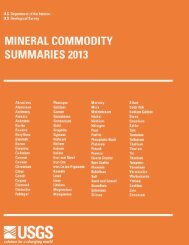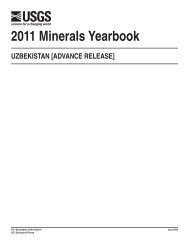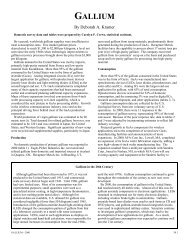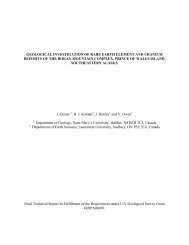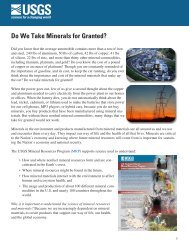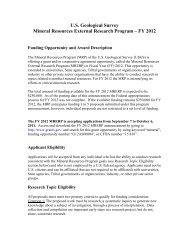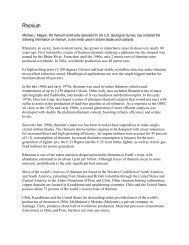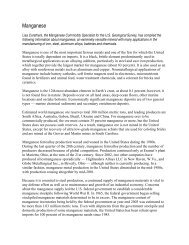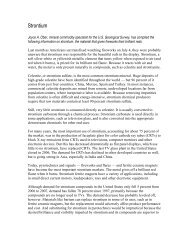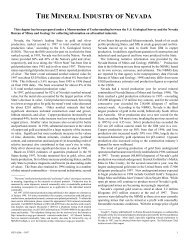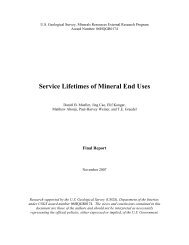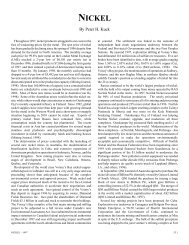Mineral Commodity Summaries 2003 - Mineral Resources Program ...
Mineral Commodity Summaries 2003 - Mineral Resources Program ...
Mineral Commodity Summaries 2003 - Mineral Resources Program ...
You also want an ePaper? Increase the reach of your titles
YUMPU automatically turns print PDFs into web optimized ePapers that Google loves.
MAGNESIUM METAL<br />
In Australia, owners of a proposed 97,000-ton-per-year primary magnesium plant in Queensland signed an<br />
engineering, procurement, and construction contract for an estimated $1 billion. Site clearing began in June, and initial<br />
magnesium production was scheduled for the end of 2004 with production at full capacity by the end of 2005. A<br />
feasability study was completed for a proposed plant in South Australia. The feasibility study recommended a 71,000ton-per-year<br />
plant, with a capital cost of A$761 million and an operating cost of A$1.06 per pound (US$0.59 per<br />
pound). Construction of the proposed plant, based on Dow magnesium technology, would be completed in 28<br />
months. Based on the result of the feasibility study, the company plans project financing in the range of A$250 to<br />
A$300 million. Another feasibility study for a 100,000-ton-per-year plant to recover magnesium from coal fly ash was<br />
completed. Capital cost of the plant was estimated to be A$857 million, and the direct operating cost would be<br />
A$0.705 per pound.<br />
China continued to plan additional magnesium capacity at many of its existing plants and propose new magnesium<br />
plants. The expansions and new capacity were expected to add about 60,000 tons per year of production capacity for<br />
magnesium ingot and about 20,000 tons per year of alloy capacity by yearend. In Congo (Brazzaville), a<br />
memorandum of understanding was signed for a long-term power contract for a planned 60,000-ton-per-year primary<br />
magnesium project. The owners also signed an off-take agreement with a German firm whereby the company will<br />
market up to 100% of the magnesium and magnesium alloys produced at the plant. Because investors have shown<br />
no interest in financing the project, a proposal to construct a 50,000-ton-per-year plant to recover magnesium from<br />
asbestos tailings in Russia has been indefinitely postponed. Magnesium production is expected to restart by the end<br />
of 2002 at the Kalush plant in Ukraine. The plant’s holding company plans to produce 500 tons of magnesium in<br />
December and 10,000 tons in <strong>2003</strong>. The plant has been closed since 1999.<br />
Production at a new 10,000-ton-per-year magnesium recycling plant in the Czech Republic began in May, and a<br />
10,000-ton-per-year recycling plant began operating in China at the beginning of 2002. Construction of a 10,000-tonper-year<br />
magnesium recycling plant in the Netherlands is scheduled to begin in the fourth quarter of 2002, with<br />
production to start about October <strong>2003</strong>. Raw material for the plants will be mainly from European die casters.<br />
New magnesium alloy components continued to be specified for applications in new North American-produced<br />
vehicles, including large components such as dashboard panels and instrument support panels. The automotive<br />
industry and the magnesium industry are working together to develop new magnesium alloys for higher wear<br />
applications.<br />
World Primary Production, Reserves, and Reserve Base:<br />
Primary production Reserves and reserve base 4<br />
2001 2002 e<br />
United States W W Domestic magnesium metal production is derived<br />
Brazil 6 7 from natural brines and dolomite, and the reserves<br />
Canada 83 88 and reserve base for this metal are sufficient to<br />
China<br />
e 200 210 supply current and future requirements. To a limited<br />
France 4 — degree, the existing natural brines may be<br />
Israel 32 35 considered to be a renewable resource wherein any<br />
Kazakhstan 16 19 magnesium removed by humans may be renewed by<br />
Norway 36 10 nature in a short span of time.<br />
Russia<br />
e<br />
48 52<br />
Yugoslavia 1 1<br />
World total 5<br />
426 422<br />
World <strong>Resources</strong>: <strong>Resources</strong> from which magnesium may be recovered range from large to virtually unlimited and<br />
are globally widespread. <strong>Resources</strong> of dolomite and magnesium-bearing evaporite minerals are enormous.<br />
Magnesium-bearing brines are estimated to constitute a resource in the billions of tons, and magnesium can be<br />
recovered from seawater at places along world coastlines.<br />
Substitutes: Aluminum and zinc may substitute for magnesium castings and wrought products. For iron and steel<br />
desulfurization, calcium carbide may be used instead of magnesium.<br />
e<br />
Estimated. W Withheld to avoid disclosing company proprietary data. — Zero.<br />
1<br />
See also Magnesium Compounds.<br />
2<br />
Rounded to two significant digits to protect proprietary data.<br />
3<br />
Defined as imports - exports + adjustments for Government and industry stock changes.<br />
4 See Appendix C for definitions.<br />
5 Excludes the United States.<br />
105<br />
U.S. Geological Survey, <strong>Mineral</strong> <strong>Commodity</strong> <strong>Summaries</strong>, January <strong>2003</strong>



